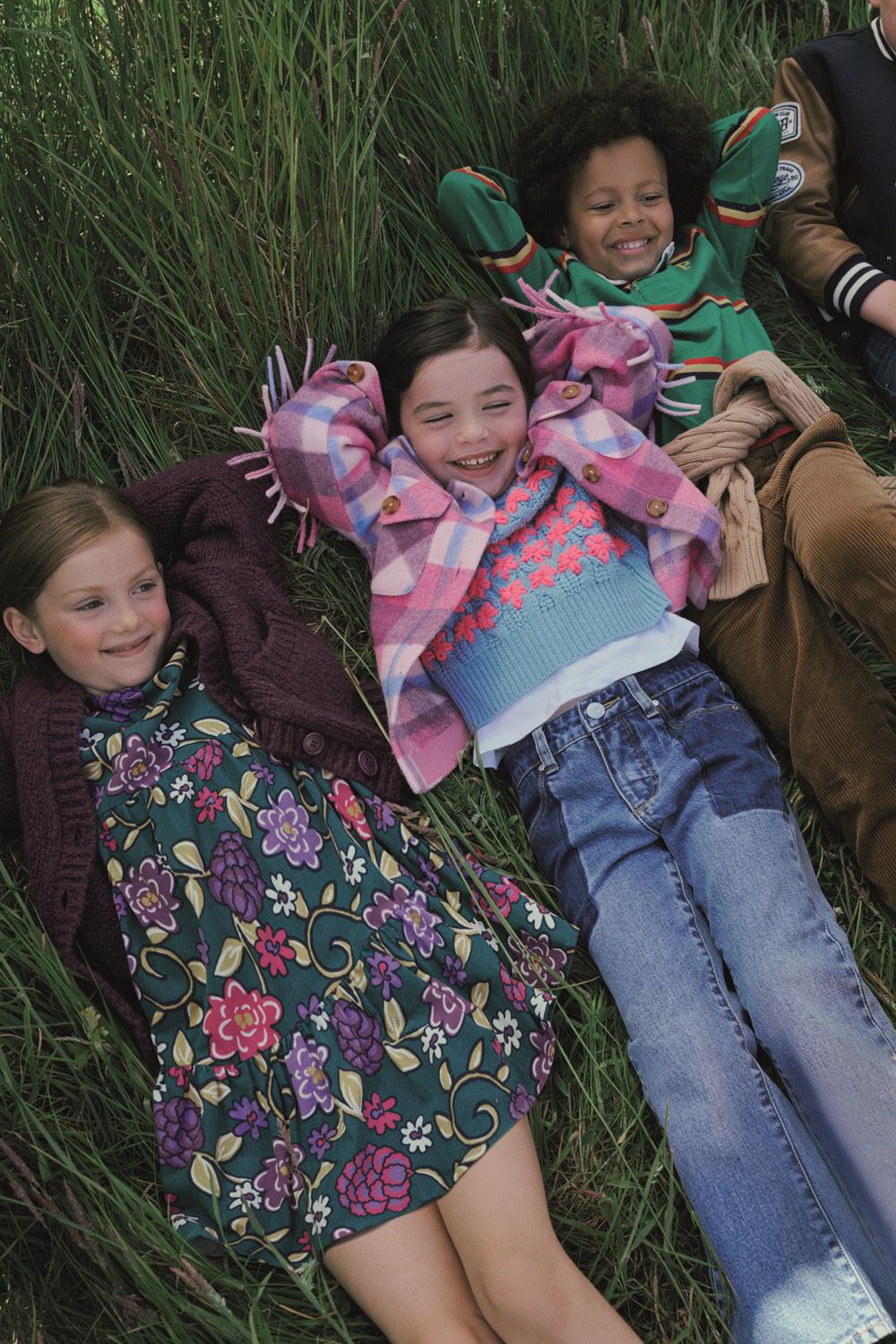RECOGNISING THE SIGNS OF ADHD
HOW TO BOOST MATHS SKILLS
MANAGING THE LOSS OF A GRANDPARENT
KEEPING KIDS HEALTHY THIS WINTER
FOUR SEASONAL STAYCATION IDEAS


RECOGNISING THE SIGNS OF ADHD
HOW TO BOOST MATHS SKILLS
MANAGING THE LOSS OF A GRANDPARENT
KEEPING KIDS HEALTHY THIS WINTER
FOUR SEASONAL STAYCATION IDEAS


EDITORIAL
EDITOR: Ella Naseeb Ryan ella.ryan@cpimediagroup.com
ADVERTISING & SPONSORSHIPS
Mathew Tharakan
mathew.tharakan@cpimediagroup.com 05 05 34 95 94
Kay Marham
kay.marham@cpimediagroup.com 05 67 68 62 68
MARKETING marketing@cpimediagroup.com
DISTRIBUTION & SUBSCRIPTIONS info@cpimediagroup.com
DESIGN
Froilan A. Cosgafa IV
FOUNDER
Dominic De Sousa (1959 - 2015)
PRINTED BY Al Salam Printing Press LLC
FOR OTHER ENQUIRIES, PLEASE VISIT: motherbabychild.com
MBCMagazine
PUBLISHED BY
HEAD OFFICE: Office 1307, DSC Tower, Dubai Studio City, Dubai, UAE P.O. Box 13700
Tel: +971 4 568 2993 Email: info@cpimediagroup.com
A publication licensed by Dubai Production City, DCCA © Copyright 2024 CPI Media Group FZ LLC. All rights reserved.
While the publishers have made every effort to ensure the accuracy of all information in this magazine, they will not be held responsible for any errors herein.
cpimediagroup.com
Hello Mum!
On the cover of this month’s issue, you’ll see that we’re exploring the impact of nurturing your child’s creativity through play. I remember finding so much happiness in imagination games, art and make-believe as a girl, but what I didn’t know at the time was just how much it was honing my problem-solving skills, innovation and ability to think independently. The learning advantages and the sense of wellbeing it brings about can be an untapped superpower for kids! Don’t miss out on this fascinating article on page 30.

November is the month where the Dubai Fitness Challenge gets into full swing, so make sure to check out our ‘Things To Do’ on page 9, for a fabulous ‘wellness and fitness’ weekend retreat happening this month, as well as a brilliant Zumba festival to help you and your kids have some fun, as you boost your energy and become a little fitter! The challenge is a really fantastic antidote to the colder months, helping your family continue to feel good through the change in season!
On page 25, we delve into ways to support your little one through the loss of their grandparent - a truly difficult event for the whole family to try and process, but especially the youngest members who might be experiencing grief for the first time. Elsewhere, there is a great piece on spotting the telltale signs of ADHD in kids, which can easily be missed if you don’t know what to look out for. Read all about how you can meet your child’s unique needs in this situation over on page 32.
With the weather cooling down and UAE National Day coming up, I’ve been thinking about taking a break for the long weekend. With families in mind, we look at a special discount rate for an exotic 4-day trip, as well as some gorgeous staycations right here in the region. Whether your family is dreaming of beachfront serenity, elevated city living or cultural charm, these mini breaks promise the chance to create some happy winter memories together.
Lastly, I’ve picked out my favourite beauty picks for you this month on page 50, including Ayurvedic hair care to keep your mane happy, and the skin treatments on special offer this festive season .
As usual, I’m not going to spill all the beans here and hope you’ll enjoy discovering this edition for yourself!
Happy reading!
Ella Editor Mother, Baby & Child Magazine
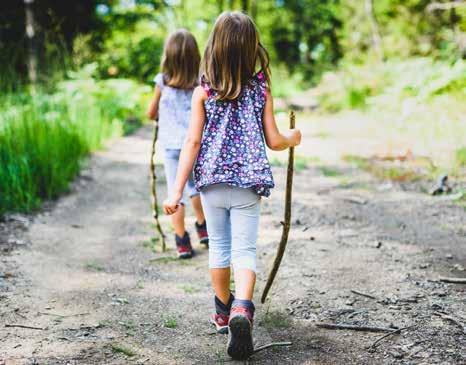
Meet No Common Scents, the wonderful new room fragrance brand! Female-founded and made in Dubai, No Common Scents products use creamy vegan, coconut soy wax, infused with essential oils and fragrances free from phthalates and parabens - all in recyclable packaging, refillable sprays and recyclable pouches for diffusers.
Their candles and room perfumes smell as luxurious as they look, with fragrances created by high-end ateliers across the globe - all designed to elevate your everyday moments. Crafted with care and lit for a cause, 20% of the sale price of every product from their ‘Soteria’ range will be delivered to an organisation dedicated to running a psychological first aid helpline.
My personal favourites from their offerings are ‘Soteria’ and ‘Beauty of the Emirates’, but their delectable scent collections come in many shapes and sizes to own, gift, refill and enjoy - because life is too short for common scents!
Explore the No Common Scents range at www.no-commonscents.com - with free next day delivery for orders over AED 270.















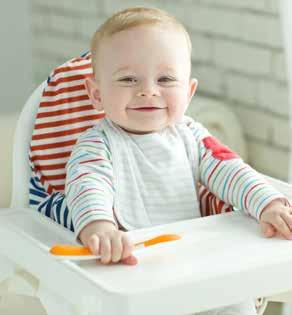
Introducing your baby to solid foods can be a really exciting, yet sometimes challenging milestone! It’s natural for new eaters to face a few hiccups as they develop their taste for solids. To make this process smoother and more enjoyable, I want to share Bumblebee Food’s newest offering with you - the ‘Starting Solids’ bundle, crafted for babies beginning their journey into solid foods.
Priced at AED 75, it has been developed with the guidance of a child nutritionist and a certified chef, providing your little one with a variety of textures and tastes to develop their young palette. The bundle includes five singleingredient purees made from pure, organic and simple ingredients, such as carrots, sweet potato, cauliflower, apple and pear. Following the highly recommended single-ingredient puree method advised by paediatricians worldwide, Bumblebee Food focuses on providing a nutritious, safe transition from milk to solid foods - one that is also super convenient for busy parents!
Learn more by visiting www.bumblebeefood.com.

New Bio-Oil® Skincare Oil (Natural) is made entirely from natural ingredients. By harnessing the power of science and nature, Skincare Oil (Natural) matches the efficacy of the original Skincare Oilthe world’s leading scar and stretch mark product.
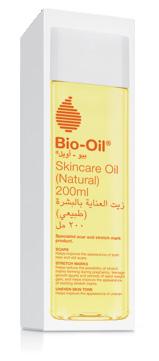

A revitalising wellness weekend; Italian food for the whole family to enjoy; fitness classes for kids and more!
Get ready to groove your way to fitness with the highly anticipated The Beach, JBR Zumba Festival, launching as part of this year’s Dubai Fitness Challenge. Running every Friday and Saturday until 24th November, from 4:30 pm to 8:15 pm, The Beach, JBR will transform into a vibrant dance floor - offering an exciting lineup of Zumba styles for all ages and fitness levels.
More than moves
Zumba isn’t just about the moves! You and your friends will also get exclusive voucher booklets packed with perks - indulge at Eataly, Chipotle or grab a sweet treat from Pinkberry. Additionally, make the most of special deals at Bath & Body Works, Rebel Swell, Adventure HQ and even a makeover at Sammy Green.
In addition to the dance sessions, instructors will host challenges for all four types of Zumba, with prizes awarded to winners. Between sessions,

there will be fun activities to enjoy, like Hula Hoops and Limbo Rock, where the MC will lead spontaneous audience challenges, offering even more prizes to keep the energy buzzing!
Here’s what you can expect at The Beach, JBR…
Feel the R&B beats in a session that captures the essence of island life, letting you groove to the hottest summer hits by the sea. Sessions will be held on November 9th and 23rd.
Immerse yourself in the vibrant world of Bollywood, with dynamic dance moves set to lively beats that bring the spirit of Indian cinema to life. Sessions are on November 1st and 15th.
Enjoy a rhythmic journey through Latin dance traditions, incorporating salsa, merengue, bachata and reggaeton for a high-energy workout. Sessions are on November 2nd and 16th.
Dive into the rich diversity of African music with traditional and contemporary dance styles that create a lively and invigorating atmosphere. Sessions are on November 8th and 22nd.
Visit https://www.thebeach.ae/en/whats-on/zumba2024 to book a spot or register for upcoming classes.

Larte, the beloved Italian restaurant at Studio One Hotel, has transformed itself into a celebration of Italian culture, art and flavour! From the moment you step inside, you and your family will feel the buzz of Mediterranean charm and flair.
From its chic interiors to an exciting menu full of mouth-watering Italian classics, like handmade tagliatelle with truffle cream sauce or delicious Tiramisu Millefoglie, Larte is the place to be! Imagine indulging in Burrata Caprese, freshly tossed pizzas from their open kitchen, or dining al fresco on the garden terrace surrounded by lush olive trees. It’s like a mini escape to Italy without ever leaving Dubai!
Open daily from midday, Larte is the perfect destination for a leisurely lunch, an afternoon coffee or a memorable family evening of authentic Italian flavours.
Visit https://larte.ae/our-menu-dubai for more information.

Wagamama’s fantastic cooking classes are now open to adults, offering a fun and interactive way to learn the secrets of preparing their delicious dishes for yourself! Whether you’re a foodie or just beginning your culinary journey, these classes are designed to spark your passion for cooking in a relaxed, social environment.
You’ll be able to enjoy a rotating menu of signature Wagamama dishes, such as Firecracker Curry, Chicken and Prawn Pad Thai, as well as crowd-favourite, Yaki Soba. Each week features a different dish, meaning you can attend multiple times and each class is its own fresh, fun experience.
Priced at AED 120 per person, the classes are available at the following venues:
• Palm Jumeirah, Dubai
• Khalifa City, Abu Dhabi
• Reem Mall, Abu Dhabi
• Motor City, Dubai
• Mirdif City Centre, Dubai
Taking place every Wednesday at 6 pm, the atmosphere is welcoming and anyone with special dietary requests can call ahead to book vegan or vegetarian options. Groups are also welcome, making it a brilliant class to bring your friends to!
Dates: Every Wednesday
Time: 6-7 pm
Price: 120 AED per person
For reservations, visit https://www.wagamama.ae/ restaurants or call your preferred outlet directly to book.
Al Wathba, a Luxury Collection Desert Resort & Spa, Abu Dhabi invites you to experience a world of rejuvenation this month, through an exclusive collaboration with Barry’s and Beyond Wellness. This immersive weekend retreat, running from the 15th to 17th November, is set amidst the stunning landscapes of the Arabian desert, where you’ll have the opportunity to truly recharge and reconnect with yourself.
Barry’s, the original high-intensity interval training workout, is renowned for its signature Red Room experience, which combines cardio and strength training for extraordinary results, whilst Beyond Wellness offers transformative sessions designed to align your body, mind and spirit. Together, they blend intense fitness with mindful movement, meditation and recovery practices - how good does that sound?!
The thoughtfully curated itinerary begins on Friday evening with a soothing sound meditation and breathwork session led by Beyond Wellness, setting a tranquil tone for the weekend. Following this, you’ll get to enjoy a welcome dinner at Terra Secca, Al Wathba’s authentic Italian trattoria.
On Saturday morning, Barry’s trainers will energise everyone with fun outdoor activities, followed by a healthy cooking class in the afternoon, full of local flavours. Between activities, you can relax by the poolside or embark on desert adventures, such as archery or Desert Crawlers, immersing yourself in the gorgeous natural surroundings.
The weekend retreat packages start from AED 3,500, offering a luxurious 2-night stay, half-board dining and access to all planned activities. Every element of this special weekend has been designed to offer an all-inclusive escape, allowing you to restore balance and find renewal in the heart of nature.
To book your spot, email reservations.alwathba@ luxurycollection.com or call +971 02-204 4444.


Ribambelle is a new venue that combines an adventurous fun play and activity area for children, while parents enjoy a fine dining experience in their own culinary adventure playground.
Set against the vibrant backdrop of Dubai’s Bluewaters, this restaurant stands out not only for its culinary offerings but for its commitment to creating a fun, enriching experience for children and a relaxing retreat for adults.
Ribambelle goes above and beyond in designing a magical space for children. With engaging workshops, whimsical installations and imaginative play areas, children can immerse themselves in a world of creativity and fun. The play area is well-equipped with toys, interactive setups and activities. The children’s play area is supervised by attentive staff, allowing kids to explore safely and independently. Ribambelle’s kids’ workshops - ranging from cooking and art to DIY crafts - give children a chance to dive into hands-on learning and play, making it a favourite for families.
Chef Gabriel’s Mediterranean-inspired fusion menu is thoughtfully crafted to offer both familiarity and innovation in every dish. The food presentation is artistic, with each plate arranged with great attention to texture and colour. It’s a feast for the eyes and taste buds alike, setting the perfect tone for a refined dining experience. Here are some of their signature dishes!
Perfectly seared on the outside, tender on the inside, the grilled salmon dish is a wonderful balance of flavours, with a fresh tomato salad, beautifully dressed to compliment the fish.
A popular choice for all ages, the cauliflower popcorn is light and flavourful, with a satisfying crunch for each bite. This dish is an ideal shared appetiser - just watch those kids tuck into this vegetable!
This salad is a beautiful balance of textures and flavours. Crisp greens, tender chicken, and a drizzle of sesame dressing bring a delightful harmony of fresh and nutty notes to your table. Chef Gabriel balances the earthiness of sesame with a slight citrusy kick, making the dish refreshing and unique.
Paired with fresh bread, the edamame hummus is a delightful start to the meal that exemplifies the fusion style of Ribambelle’s menu.
While tailored to be family-friendly, the pizzas at Ribambelle don’t compromise on flavour or quality. The pizza crusts are perfectly crisp and toppings are thoughtfully chosen to appeal to both kids and adults alike, with ingredients that highlight Mediterranean influences. Ribambelle is a rare gem that successfully blends fine dining with family-friendly entertainment, ensuring both parents and children have a memorable time.
For more information or to book, visit www.ribambelle.ae. THINGS



Keeping healthy through winter; how to navigate menopause; how children’s gait develops and more!
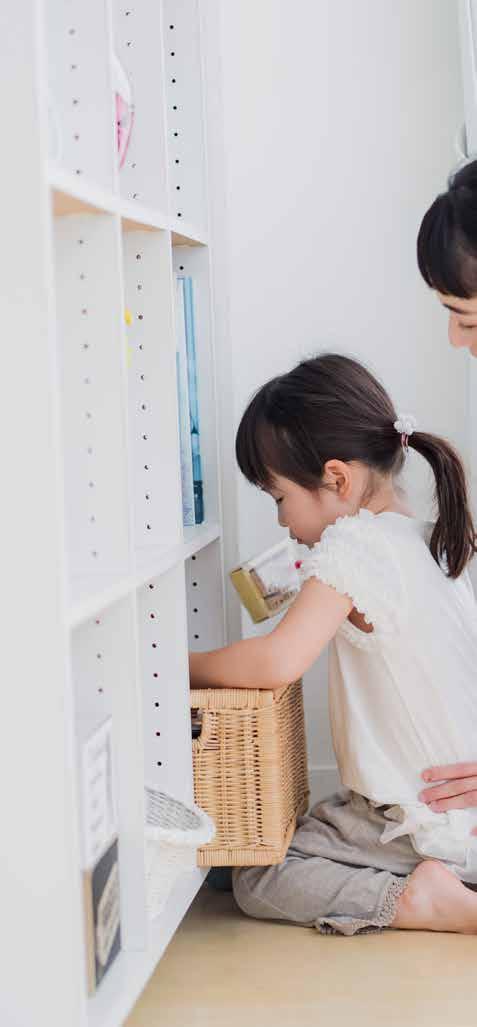
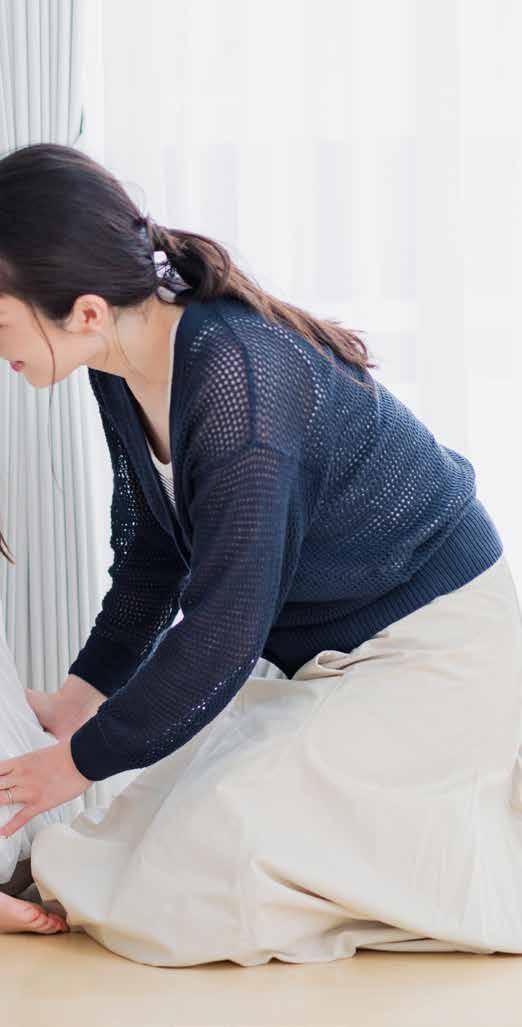
Many of us feel pressure to get our homes ‘ready’ for this time of year. We look at how to clear out your home for a stress-free approach to festivities.
As the festive season approaches, many families find themselves caught in the whirlwind of shopping, decorating and planning. Amidst the excitement, it’s easy to overlook the clutter that accumulates throughout the year in our homes! Embracing a decluttering mindset before the holiday season truly kicks in will not only give you the gift of a more organised home, but it also paves the way for a calmer, more enjoyable November and December ahead. Here are some practical tips and tricks to help your family simplify your possessions effectively, making space for what truly matters over the coming weeks.
Start your journey by setting clear, achievable goals as a family. Discuss what areas of your home need attention and how you want your space to feel during the holiday season. Do try and make sure to get your little ones’ thoughts, so they feel happier about helping and more satisfied with the outcome. Do you want a tidy living room for family gatherings? Or perhaps a clutter-free kitchen for baking treats? By involving everyone in the decision-making process, you’ll lay the foundations for a lovely sense of teamwork and purpose this festive season.
Consider creating a list of specific goals, such as clearing out the playroom, organising the pantry or simplifying your seasonal decorations. This makes it easier to break the

overall task into manageable chunks, and it’s also handier to delegate from a list, meaning each family member has a useful role - whether it’s sorting through toys, cleaning out closets or tackling kitchen cupboards.
Decluttering can feel overwhelming, so just focus on one room at a time. Start with the area that causes the most stress or where your family spends the most time. This approach not only makes the process less daunting but also allows for lots of morale-boosting signs of progress, which can be motivating for everyone.
While working in each room, sort your items into three categories - keep, donate and bin - and encourage your family to be honest about what they truly need and use. Remind yourselves that letting go of unused items can make space for new memories and experiences during the holidays and for the upcoming new year.
Decluttering doesn’t have to be a chore - with a few small tweaks it can be a fun and engaging activity for the whole family! Get your children involved in the process by encouraging them to sort through their own belongings. If you need to, create little games or challenges, such as setting a timer to see how many items they can get rid of in five minutes or having a friendly competition to find the most toys to donate. These
small techniques can really make a huge difference to how kids respond to the situation!
Teaching little ones the value of decongesting your possessions is a natural way to instil lifelong habits of organisation and mindfulness about what they own. It can also be good to explain the importance of donating gently used items to those in need, in an age-appropriate wayreinforcing the spirit of giving during the festive season.
It’s useful to designate a specific box or bag for items that will be donated, and place it in a visible spot to encourage the whole family to add objects as they tidy out different areas. A big decluttering of the house can also pave the way for you to make regular trips to your local charity or donation centre a part of your routine throughout the year going forward. Not only does this clear out your home more often, but it is also a nice way for your household to contribute to the community.
With the festive season almost upon us, it’s essential to organise your decorations. Take stock of what you have - are there ornaments or lights that haven’t been used in years? This is a really great activity to involve the whole family in, reminiscing about past Christmases, as you decide what to keep and what can be let go.
When packing away decorations, consider using clear bins or labelled boxes to make finding items easier in the future. That way, you’ll save time and money next year!
As you prepare for the holidays, try adopting a minimalist mindset. This doesn’t mean giving up everything you love - rather, it’s about prioritising quality over quantity. Encourage your family to focus on meaningful gifts and experiences rather than accumulating more ‘stuff’, just weeks after clearing out the house.
A fun concept that you could discuss with your loved ones is the idea of gift exchanges, where you each choose a limited number of gifts or even opt for experiences like a family outing or cooking together. This can significantly reduce the clutter associated with traditional gift-giving, while setting the stage for some fun and interesting memories together.
As you declutter and make space for the holiday season, it’s essential to consider how to manage the influx of new items that come with gifts. Encourage your family to be intentional about where they’ll put new toys, clothes or decorations, and have a plan ahead of time.
For every new item that comes in, ask family members to let go of something else. This ‘one in, one out’ approach helps maintain balance and prevents the same level of congestion from building up again. Creating a habit of mindful consumption could actually become part of your holiday tradition, alleviating some of the environmental stress and pressure that can build up at this time of year.
In addition to physical clutter, don’t forget about digital spaces. With the holidays often bringing an influx of digital content - photos, emails and subscriptions - it’s essential to streamline these areas as well. Set aside time as a family to organise digital files, delete unnecessary emails and unsubscribe from unwanted newsletters.
Consider creating a shared family album for holiday photos, ensuring everyone can contribute and enjoy memories without getting lost in a sea of files. This not only keeps your digital life tidy but also is a nice way to share in the experience together.
Once the holiday season is over, it’s important to maintain the momentum of your decluttering efforts. Encourage your family to make it a regular practice by setting aside a few minutes each week to tidy up and assess belongings. This can help prevent things from building up again and create a more peaceful living environment year-round. You could even consider implementing a monthly challenge where everyone picks one area to organise. This encourages ongoing teamwork and reinforces the practice of an organised, clutter-free home as part of your household’s values.
By taking the time to declutter before the festive months really kick into gear, your family can create a welcoming, stress-free environment, one that emphasises togetherness and the spirit of giving. With a little planning and teamwork, you and your family can transform your home into a clutter-free haven, perfect for enjoying all the cosiness, warmth and connection this season has to offer.

What is typical when it comes to gait development, what could be cause for concern and how you can support your little one as they find their feet?
Watching your child take their first steps is one of the most thrilling milestones in their early years. However, for some children, walking may not come as easily and in these cases, concerns about gait development might arise. Gait simply means the way in which a person walks, and like all aspects of development, it can vary widely between kids. While many differences are part of a child’s natural growth and may resolve on their own, some may indicate an underlying issue that needs attention.
Most children begin walking independently between a year and fifteen months, although some may start as early as nine months or as late as eighteen months. In the early stages, it’s common for little ones to display an unsteady gait, often with wide-based steps, arms held up for balance and a bit of wobbling. As they grow, they gradually gain strength and coordination, which leads to a more stable, balanced walk.
During the toddler years, a child’s gait can go through various phases, including toe-walking, in-toeing (pigeon-toed gait) and out-toeing. These can often look worrying to parents, but most of these phases are just part of development and will improve as muscles strengthen, bones grow and coordination gets better.
While it’s true that many gait variations are temporary and improve on their own, there are a few signs that parents should watch for, which could indicate a more persistent issue. Let’s take a look!
While occasional toe-walking can be part of exploring movement, consistent toe-walking, especially if your child is not placing their heels on the ground, might signal tightness in the Achilles tendon, muscle weakness or neurological concerns.
In-toeing and out-toeing are quite common when a child first learns to walk. However, if these patterns persist beyond the age of three or appear to worsen, it’s worth seeking advice from a paediatrician or physiotherapist.
If you notice that your child is consistently limping, favouring one side or displaying a noticeable difference in leg movement, it may indicate a structural or muscular issue that needs attention.
If your child regularly complains of pain in their legs, seems overly tired after walking or is reluctant to walk at all, it’s definitely important to investigate further. Pain is not typically part of normal development, so this certainly warrants a closer look.
A child who drags one foot while walking or often trips over may have a muscular

imbalance or a neurological issue. Frequent tripping could also indicate a developmental delay in coordination.
Gait issues can happen through a variety of factors, some more common and benign, and others that may need medical intervention. Here are a few possibilities.
This occurs when the arches of your child’s feet don’t develop fully, causing their entire foot to press against the ground. While this is usually not painful, it can affect their gait.
Developmental dysplasia of the hip (DDH)
DDH happens when the hip joint doesn’t form properly, leading to instability. It’s often

detected early on, but mild cases can go unnoticed until a child begins walking.
Perhaps the most well-known on this list, this neurological condition affects muscle tone and movement, often resulting in stiff or floppy muscles that impact gait.
Weak or tight muscles in children’s legs, particularly the calf or hamstring muscles, can lead to difficulties in maintaining a balanced walk.
There are several ways parents can support their child’s walking journey and encourage healthy gait development.
Whenever it’s safe and practical, it’s good to let your child walk barefoot. Barefoot walking helps strengthen the muscles in their feet and legs, encourages the development of their arches, and allows for better proprioceptionawareness of where their body is in space.
Movement is the key to muscle development and coordination! It’s wise to encourage activities like walking, running, climbing and balancing. Gentle stretching exercises can also be beneficial, especially if your child has tight muscles. You can even turn this into fun ‘together time’.
Try to avoid rigid shoes or those with a lot of arch support for young walkers. Instead, opt for flexible, lightweight shoes that allow
plenty of natural foot movement. As children get older, choose shoes with good support, but without restricting their foot flexibility.
If you’re worried about your child’s gait, a visit to a paediatrician or paediatric physiotherapist can help determine whether there’s cause for concern. They can provide guidance, suggest exercises, or recommend orthotics or therapy if needed.
If you decide to consult a professional about your child’s gait, a thorough evaluation will typically include an assessment of their muscle strength, flexibility, joint alignment and neurological health. Depending on the findings, your little one may benefit from a tailored exercise programme, physical therapy or, in rare cases, surgical intervention.
It’s always better to address potential issues early, as timely intervention can often prevent long-term problems and ensure that your child develops a strong, stable gait.
It’s important to remember that everybody’s walking journey is unique and a wide range of variations in gait can be entirely normal. As a parent, staying informed and observant is key, but try not to worry too much about minor differences unless they persist or cause your child discomfort. With the right support and a watchful eye, most children will grow into confident walkers in no time!
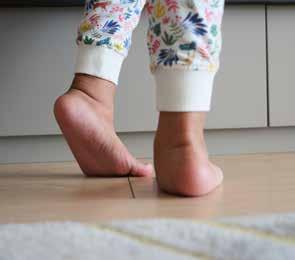
This month, our editor caught up with Anastasia Hortman, owner of Hortman Clinics, on how they can help mothers going through hormonal changes.
What is Hortman Clinics and what makes it unique?
Hortman Clinics is a premium wellness centre in Dubai committed to redefining beauty, wellness and health through personalised and patient-focused care. Drawing inspiration from Dubai’s leadership in global healthcare innovation, Hortman Clinics takes a holistic approach, offering tailored treatment plans that empower clients to achieve their individual health and beauty goals.
We recently launched Sofwave, a cutting-edge, non-invasive technology aimed at improving and enhancing the overall collagen and elastin production of skin. We really pride ourselves to be one of the first early Sofwave technology adaptors in the region, highlighting our dedication to being one of the top technology innovators when it comes to their services and overall business ethos.
What made you interested in starting a business in the wellness category?
My decision to enter the wellness industry was driven by a passion for helping people live healthier, more fulfilling lives. In today’s fastpaced world, the need for personalised, holistic care is more important than ever. Dubai’s reputation as a leader in healthcare innovation inspired us to create a space where we could combine cutting-edge medical advancements with a patient-centric approach to wellness. By focusing on beauty, health and overall wellbeing, we saw an opportunity to offer customised treatment plans that not only address specific concerns, but also empower individuals to achieve their long-term health and beauty goals.
What are some of the most taboo topics you think that the general public is still lacking knowledge in?
Topics related to women’s health, such as perimenopause and menopause, are often

spoken in hushed tones or among women in privacy. The most common topics that are considered a little taboo or that people don’t know enough about yet include menstrual disorders like endometriosis, hormonal disorders and hormonal imbalance caused due to chronic conditions like PCOS and menopause.
Perimenopause and menopause are not discussed as much as they should be. Can you walk us through the stages a woman goes through and the changes she can expect?
Perimenopause and menopause are stages in a woman’s life when she is transitioning from
her reproductive to non-reproductive years. Every woman’s experience is unique, including her symptoms, physical, mental and emotional health.
Perimenopause in a woman begins when she is in her mid-30s and can last anywhere between up to a decade. The ovaries begin to produce less oestrogen, and progesterone levels also fluctuate. While periods still occur, they become irregular.
The next phase is menopause, which usually occurs between 45 to 55 years. A woman is considered to have attained menopause if she doesn’t have a period for 12 consecutive months.
The next phase is post-menopause during which a woman does not get her periods and many of her menopausal symptoms subside or reduce.
You have a revolutionary approach to this phase of a woman’s life. Tell us more about menoSTART.
At Hortman Clinics, this is a very important topic for us and hence we have partnered with Medi-Gyn to offer a unique modern menopause management programme which we have called ‘menoSTART’. Our experts design every hormone balancing protocol for each patient, so that it fits perfectly to their specific needs, but we also believe you must own your menopause, accept it and move forward with positivity during this period.
What kind of techniques and practices are involved?
In our menoSTART programme, we offer the following services:
• Holistic gynaecology consultation
• Functional medicine consultation that evaluates your current concerns, symptoms, medical and health history
• Latest and innovative diagnostics like the TOPI Scan
• Prescription of BHRT/peptide therapy or peptide bioregulators
• Science-driven supplements
• Creating your own Modern Menopause Protocol
• Science-based menopause nutrition, mental and physical fitness, lifestyle hacks to

increase your health-span and decrease your biological age
• 24/7 access to our medical doctor
Finally, a follow up for an 8-week period to review the whole treatment is a must.
How impactful is hormone balancing for a woman’s wellbeing and how does it work?
Women experience hormonal changes all through their life - from menarche to menopause. Hormonal imbalances can wreak havoc in a woman’s body and affect her physical, mental, emotional and psychological health and wellbeing. At Hortman Clinics, our team of experts understand the importance of hormone balancing and work with each individual to create a bespoke treatment.
In addition to our hormone protocols, we also have a functional ‘whole body approach’ to get to the root cause of a condition rather than just treat the symptoms only.
Does biological age differ from chronological age?
Chronological and biological ages are different, and in most individuals, they rarely coincide.
Biological age refers to how old your body appears to be based on cell markers and indicates how fast or slow your body is ageing. Chronological age is what you measure from your birthday.
Ideally, your biological age should be less than your chronological age. However, several lifestyle factors influence the body’s ageing process and therefore its biological age.
You take an integrative approach to women’s health. Why is this so important?
At Medi-Gyn, our incorporated company within Hortman Clinics, the team under the leadership of Irina Bond, focuses on an integrated and comprehensive approach to manage women’s health. We believe that every condition has a specific root cause and simply managing the symptoms is not a long-term solution in today’s day and age, not for a modern woman with many responsibilities on the go.
Taking an integrative approach, we believe we can achieve a total healing of your condition and prevent future flare-ups.
How can our readers book in for a consultation with you?
To book a consultation with Medi-Gyn, an incorporated company within Hortman Clinics, please call +971 55 545 0797 or email info@medi-gyn.com.
For more information, visit www.hortmanclinics.com.
Now that the cooler weather has arrived, it’s time to think about wellness strategies to keep your family healthy this season.
As the cooler months hit the UAE, families face the unique challenge of keeping their children healthy during winter. While the mild temperatures are a relief from the scorching summer heat, they also come with the onset of seasonal illnesses like colds and flu. However, with a bit of planning and some easy strategies, you can help your children stay healthy, active and well throughout the winter season. Let’s take a closer look.
A strong immune system is at the heart of your child’s health, especially during the winter months. One of the most effective ways to enhance their natural immunity is through a balanced diet rich in vitamins and nutrients. Whether it’s solely from food or aided with supplementation, it’s very important to make sure that you’re giving your child the vitamins that they need to ward off the bugs and viruses that come out in force during this part of the year. Multivitamins are also available, making the supplementation process more straightforward - but it’s always better to get as much as you can through food. Here are some of the most important vitamins and minerals to focus on throughout winter:
• Vitamin A
• Vitamin C
• Vitamin D
• Omega-3
• Zinc
Vitamin A
This important vitamin is great for your child in three main ways. It boosts their immune system, it aids their skin health and it’s good for

their eyesight, all things that they need during the cooler months. Foods that have a lot of Vitamin A include fish, eggs, dairy, carrots and leafy green vegetables such as broccoli and spinach.
Vitamin C
One of the most well-known nutrients on the list, Vitamin C is central to good immunity, as well as staving off anaemia and helping wounds or irritated skin heal faster. Getting enough is easy if you encourage your family to enjoy a variety of brightly colourful fruits and vegetables. Citrus fruits like oranges and grapefruits are abundant and rich in vitamin C, while seasonal produce such as pomegranates, dates and figs can be both tasty and nutritious.

A super-vitamin, this nutrient plays an essential role in modulating your little one’s immune responses. While the abundant sunshine of the region makes it unlikely they will be deficient, it’s still good to add in some foods rich in Vitamin D anyway. These include oily fish, red meat, eggs and fortified cereals.
Not only does omega-3 help your child’s immune system and growth, it can also help
prevent anxiety and depression, which can sometimes be worse during winter. Omega3s are most easily found in oily fish, such as mackerel or sardines, nuts, seeds and avocados.
Getting enough zinc is very important for your little one’s health and fortitude. It works best when they’re also receiving enough Vitamin C and is very powerful at keeping harmful bugs and viruses at bay. Fortified cereals, along with meat, fish and milk are the main food sources to include for zinc.
Even in winter, staying hydrated is essential, especially in the dry climate of the UAE. Kids often forget to drink enough water when the temperatures drop, so it’s best to remind them, encouraging your children to drink water regularly throughout the day. To make it fun, consider allowing your little ones to decorate their water bottles or infuse their water with tasty flavours like lemon or mint. Warm beverages, such as herbal teas or warm milk, are also comforting alternatives during chilly evenings.
Happily, the winter months in the region are milder, and with a cooler breeze comes more outdoor activities! Regular exercise is vital for maintaining kids’ physical health and boosting their mood, and it plays a huge role in keeping them well.
Outdoor activities on the weekend, such as cycling, exploring parks, or enjoying water sports at the beach, makes for great family time with lots of health benefits. The UAE offers numerous family-friendly outdoor locations, like Al Ain Oasis or Hatta, which can provide an excellent backdrop for fun physical activities. You could even look for community events that offer group sports or fitness classes, making exercise a social activity for the whole family.
Maintaining a consistent routine is especially important during winter when days can feel longer and more relaxed. A regular schedule


for meals, homework and bedtime will create a stable foundation for your children’s mental and physical health. Work together as a family to set a routine that includes time for homework, chores, family activities and relaxation - having structured time for exercise and downtime can really help children manage their stress and improve their mood.
During the cooler evenings, consider introducing a ‘family night’ where you enjoy a movie, play games or do some crafts together. This not only keeps kids happy but it also gives you the chance to try a different type of family time during the winter months.
Good sleep is essential for a healthy immune system and overall wellbeing. As the sun sets earlier, use this opportunity to establish a calming bedtime routine and aim for consistent bedtimes and wake-up times to help regulate your child’s internal clock.
It’s wise to work on creating a relaxing atmosphere in your little one’s bedroom with soft lighting, comfortable bedding and a quiet environment. Pair this soothing environment
with daily screen-free time before bed to allow children to wind down with reading or other calming activities. This can really help improve sleep quality and make mornings much easier, as well as giving kids the proper rest they need to stay in good health through the colder end of the year.
In the wake of the pandemic, we all now know how good hygiene practices are particularly important in combating seasonal illnesses. So, make it a family habit to wash your hands regularly, especially before meals and after being in public spaces. To get children on board, turn handwashing into a fun activity by playing a song that lasts for at least 20 seconds - this makes the task feel less tedious for everyone. Also, it makes sense to pack some hand sanitiser in your child’s school bag, for times when soap and water aren’t available, or for when there are a lot of bugs going around the classroom.
While it can be tempting to stay indoors when the temperatures drop, spending time
outside has a huge influence on children’s health. Natural light boosts their mood and vitamin D levels, both of which are vital during the winter months, and it also keeps their circadian rhythm at its best, which also plays a role in good immune responses.
Family outings to parks or the beach, or trips to local attractions outside, such as desert safaris or Dubai Parks and Resorts, will allow your children to enjoy the pleasant winter weather while staying active in a way that feels like a treat!.
Despite your best efforts, some illnesses are inevitable during the winter months. It makes things easier to be prepared, by keeping a well-stocked first aid kit and having a thermometer on hand. If your child has allergies or asthma, take extra precautions during winter by keeping any potential triggers, such as dust or cold air, to a minimum.
With a little planning and teamwork, leaning on these strategies will help your family navigate the winter months with joy and vitality, ensuring that everyone remains strong and healthy through the season.
The theme for this month’s free breakfast event for parents was ‘Igniting Curiosity and Nurturing Potential In Early Childhood,’ sponsored by Blossom Nursery, Al Ain Farms and Jumeirah International Nurseries. Here’s a quick rundown of what we discussed at the event!




• DATE: Thursday 24th October 2024
• VENUE: Stella di Mare Hotel, Dubai Marina
• THEME: Igniting Curiosity and Nurturing Potential In Early Childhood
• SPONSORS: Blossom Nursery, Al Ain Farms and Jumeirah International Nurseries
The breakfast event opened with a welcome address from Veronica Martin, before introducing the first guest speaker.
The opening talk was from Katrina Mankani, Managing Director at Jumeirah International Nurseries, who talked about igniting curiosity and creativity in the early years through the lens of positive education and innovation.
Katrina was very engaging, approachable and open with the audience, shedding light on ways to bring out creativity and better overall development in young children during their early years.
She emphasised the importance of carefully structured learning environments that inspire kids’ imaginations, allowing children the freedom to discover new ideas.
Educators, she noted, play a huge role in this process by providing guidance, while also granting children the space to express themselves independently. Katrina highlighted that looking after your little one’s wellbeing is an essential aspect of this journey, as it contributes to both their immediate creativity and their long-term success.
She shared that positive education - an approach focused on building character and emotional strength - is shown to ignite a lifelong love of learning in kids. Also, she discussed how integrating innovation into early years education sows the seeds for creativity, while helping children become more well-rounded individuals.
The second expert speaker was Zaina Shihabi, Centre Director at Blossom Nursery Mudon. She spoke about how to work in partnership to develop critical thinkers from an early age.
Zaina was detailed and knowledgeable, focusing on the link between critical thinking skills in young children and their personal, social and emotional development.
She explained that critical thinking in this age group involves helping children analyse, reason and solve appropriate problems.
Starting early is key, as nurturing these abilities from a young age sets the foundation for good lifelong learning, independence and better decisionmaking abilities. Zaina shared practical ways parents and educators can encourage curiosity and problem-solving, such as asking open-ended questions and allowing their children to explore solutions on their own.
She highlighted the importance of collaboration between parents and teachers to create consistent frameworks and activities that grow little ones’ critical thinking in everyday situations. Finally, Zaina outlined the need for environments - both at home and in classrooms - that promote independent thinking, where children feel safe to explore ideas, make choices and reflect on their experiences.
The breakfast morning ended with fantastic goody bags from Al Ain Farms, who gave away delicious juices and thick and nutritious Greek yoghurt.
Keep an eye on the website and your email for details of our next event!
Spotting ADHD in kids; the benefits of creative playtime; the power of saying ‘How about we…’ and more!
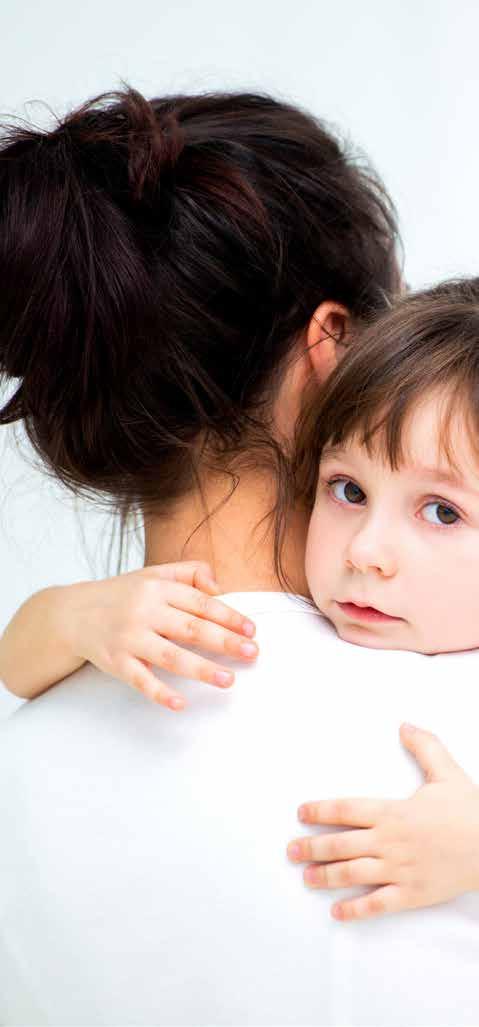
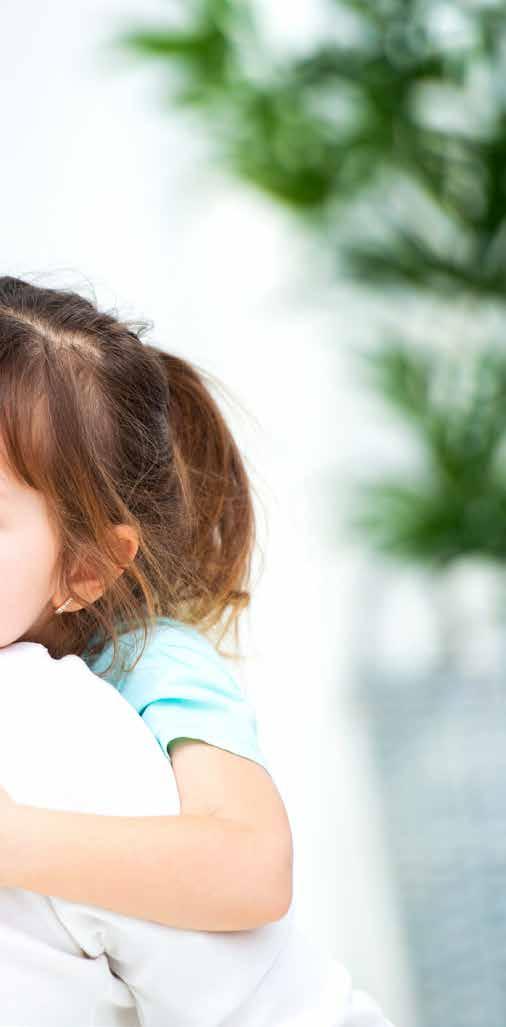
When a grandparent passes away, it can be so difficult for children to process. Here are ten strategies to help your child with their emotions.
Helping children cope with the loss of a grandparent can be an emotional and challenging journey for any family. For many children, this might be their first experience with grief, so guiding them through it with compassion, understanding and patience is key. Here are ten ways to help children navigate these difficult emotions while feeling safe, loved and supported.
When a grandparent passes away, children often have questions. While it can be tempting to shield them from sadness, using age-appropriate honesty is important. Avoid euphemisms like “gone to sleep,” as they can lead to confusion. Instead, gently tell the truth in the way that feels most comfortable or right for your family. Encourage questions and validate their emotions, letting them know it’s okay to feel sad, confused or even angry.
For younger children, use simple language and avoid overwhelming details. Older children may have more complex questions, so you can delve into the topic a bit deeper, ensuring that they understand what’s happened without getting overly technical.
Helping your child remember their grandparent’s life can bring comfort. Talk about the qualities that made their grandparent so special, the memories they shared and the fun times they

had. You could create a ‘memory jar’ together, where family members write down memories on slips of paper to place in the jar. This can help children focus on the positive aspects of their grandparent’s life and cherish the bond they had.
You might also create a scrapbook or photo album together, adding pictures, notes and drawings. This activity can help them understand that, even though their grandparent is no longer physically present, the memories and love they shared will always remain.
Children can struggle to express grief because they may not fully understand what they’re feeling. It’s best to gently coax your child to talk about their emotions and remind them that there’s no ‘right’ or ‘wrong way to feel. Some kids might express sadness, while
others might feel confused or even guilty. Let them know all feelings are valid and that talking about them can help.
If your child isn’t ready to talk, it might be better to get them to express their feelings in other ways, such as drawing or writing. Art can be a therapeutic outlet for little ones to explore their emotions when words feel too difficult.
After a grandparent’s passing, keeping to familiar routines can provide a sense of stability and security for young children. Even if emotions are high, try to maintain regular mealtimes, school schedules and family activities. Familiar routines can help children feel grounded and remind them that, despite the changes, their world is still a safe and predictable place.
Of course, be flexible when needed - some days may be more challenging than others and it’s okay to allow for extra time to rest or relax if your child needs it.
Involving children in any farewells, such as a memorial or funeral, can give them a chance to say goodbye in a meaningful way. Let them know what to expect and, if appropriate, give them the option to participate in a way that feels comfortable for them. For instance, they might want to bring a drawing, read a poem or place a small object of theirs with their grandparent. These gestures help children feel involved and provide a sense of closure.
If a traditional funeral feels too overwhelming, consider creating a special family ritual instead. You could have a
quiet family dinner in memory of their grandparent, visit a favourite spot they enjoyed, or release balloons with messages. Do what feels best for your family, but make sure children have the opportunity to take part in saying goodbye.
Stories are a powerful way to help children understand complex emotions. Many children’s books cover topics like grief and loss in ways that are both sensitive and accessible for kids. Reading stories about characters who experience similar losses can help children feel less alone in their grief and provide examples of healthy ways to cope.
Some popular choices include The Invisible String by Patrice Karst, which teaches that love connects us even after someone is gone, and When Dinosaurs Die by Laurie Krasny Brown, which addresses various aspects of death and grief in a simple, reassuring way.
Grief isn’t a one-time event - it’s an ongoing process that children may revisit over time. A child who seems to have moved past their sadness may experience a new wave of grief when faced with reminders or significant events, such as holidays or birthdays. Be patient and open to revisiting the conversation as new questions or feelings arise.
Children may also express grief in ways that don’t look like sadness. Changes in their behaviour, sleep patterns or even school performance can all be signs that they’re processing their emotions. Check in with them gently and offer your reassurance as they work through their feelings.
When a loved one dies, children may feel uncertain or even fearful about losing others they care about. Reassure them that, while loss is a part of life, they are safe and loved. Let them know you’re there for them, you can answer questions and you’ll help them through tough days. Remind them that they’re surrounded by people who care for them.
If they’re struggling to sleep due to worry, consider creating a comforting bedtime routine that includes relaxing activities, such as reading, listening to calming music, or simply spending a few extra minutes together.
After a grandparent’s loss, leaning on family members can help children feel a sense of unity and shared emotions. Encourage time with their close relatives - like aunts, uncles and cousins - who may also be grieving. This shared experience can help children understand that loss is something others experience too and that they aren’t alone in their sadness.
Family gatherings, even informal ones, can offer a comforting environment for everyone to feel supported. Sharing stories, looking at photos or simply being around each other can be soothing and affirming.
While grief is a normal response to loss, some children may need additional help. If your child seems to be struggling long-
term - displaying symptoms of depression, withdrawal, prolonged anxiety or drastic behavioural changes - it may be best to speak with a counsellor or child therapist. Mental health professionals are equipped to help children navigate difficult emotions and can provide coping strategies tailored to their age and personality.
Seeking help isn’t a sign of weakness - it’s a way to ensure that your child has the tools they need to process loss in a healthy and constructive way.
Coping with the loss of a grandparent is a process that takes time, understanding and compassion. By creating a safe and loving environment, you can help your child move through their grief in a healthy way. By supporting them through this experience, in both words and actions, you’re helping them build resilience and find peace, even in the face of loss.


Here’s why the simple phrase ‘How about we…’ can be a game-changer during challenging parenting moments!
Knowing exactly what to say in tricky situations as a parent isn’t always easy. With so much advice and information out there, it can sometimes feel overwhelming. When your little one’s behaviour becomes stressful or challenging, having the right words to guide the moment is essential. While there’s no onesize-fits-all approach to parenting, a versatile phrase that can work wonders is “How about we…?” This phrase not only helps you navigate difficult moments, but also creates
opportunities for your child to feel included and empowered, while encouraging them to choose positive behaviour.
Discipline isn’t just about correcting bad behaviour - it’s about teaching kids how to make better choices. This is where the power of “How about we…” comes in. When a child
makes a mistake or behaves inappropriately, rather than focusing on what went wrong, this phrase shifts the conversation towards solutions.
It’s all too easy to fall into a cycle of using harsh words or the knee-jerk response of “Don’t do that!” Instead of this, try saying, “How about we take turns with the toy next time?” or “How about we use our words instead of getting upset?” This gentle
redirection focuses on what to do differently, reinforcing positive behaviour in a way that feels constructive rather than punitive.
Using “How about we…” helps children feel like they’re part of the process and gives them the sense that they have the power to make better choices. It transforms mistakes into learning opportunities, encouraging your child’s growth without the negativity that comes from punishment.
One of the reasons this phrase works so well is that it creates a sense of togetherness.
Saying “How about we…” implies that you and your child are on the same team, working together to figure out the best course of action. This approach reduces the feelings of isolation and defensiveness that can arise from being told off, and instead promotes connection and cooperation.
When kids feel included in the decisionmaking process, they’re more likely to engage with you positively. For example, if your little one is refusing to tidy up, instead of demanding, “Clean up your toys!” try asking, “How about we clean up together, so we can have more space to play?” This phrasing not only sounds less confrontational, but it also encourages teamwork and makes the task feel less daunting.
By making the experience more collaborative, you’re nurturing your child’s sense of responsibility while reinforcing the message that they’re not facing challenges alone.
Another great trick is to pair “How about we…” with the phrase “so that” to explain why the action matters. This shows your little one the reasoning behind the behaviour you’re encouraging, reinforcing the value of good choices.
For instance, you could say, “How about we put the crayons away, so that we don’t lose them?” or “How about we share the last cookie, so that everyone gets a piece?” This simple explanation helps your child understand the impact of their actions and the positive outcome that follows. It teaches them that good behaviour isn’t just expected for its own sake - it has real benefits for everyone.

“How about we…” isn’t just for young children - it can be adapted for older kids too. As children grow, they need to feel more in control and independent. To encourage this, you can use “How about we…” as a jumping-off point to give kids a greater sense that you’re asking and not telling, which creates the feeling that you see them as more responsible and mature.
With older children, try framing it as a suggestion rather than a directive. For example, “How about we talk about what happened earlier?” or “How about we figure out a way to solve this together?” This keeps the dialogue open, showing your child that their input matters while still guiding them towards better decisions.
It can also be a great way to navigate delicate conversations. If your pre-teen is feeling overwhelmed with schoolwork or social pressures, asking “How about we look at
your schedule together, so you don’t feel so stressed?” opens the door to problemsolving, without sounding like a lecture.
Ultimately, using “How about we…” shifts the focus from what went wrong to what can be done right. It sends a clear message to your child that mistakes aren’t the end of the world - they’re opportunities to learn and improve. This positive framing not only helps kids feel better about themselves in the moment, but it also teaches resilience and problem-solving skills they’ll carry with them into adulthood.
In tricky parenting moments, the words you choose can make all the difference. “How about we…” is a simple, yet powerful phrase that helps you turn everyday challenges with your little one into chances to grow, helping your child become more confident, capable and ready to face whatever comes next.
Inspire your child’s creativity with playful, everyday activities that are easy to adopt into your daily life.

Creativity in young children is about far more than painting, drawing or crafting. It’s a vibrant, exploratory process that involves imagination, problem-solving and playing - often all wrapped into the same activity. For parents, this doesn’t have to be a daunting or time-intensive task. In fact, some of the best ways to nurture your little one’s inherent creativity are simple, everyday activities that children enjoy.
Creativity is a powerful tool for learning and self-expression. Through innovative play, kids develop key skills - they learn to think critically, build their emotional resilience and navigate challenges with a flexible, positive approach. Imaginative activities also support
their cognitive and emotional development by allowing children to express their thoughts, feelings and ideas.
Let’s take a deeper look at the things you can do to bring out your child’s individuality.
Children are naturally curious and their questions open the door to creative thinking. When your little one asks, “Why is the sky blue?” or “How does a caterpillar turn into a butterfly?,” take the time to explore these questions together. You don’t need all the
answers - just fostering their natural curiosity helps them learn to think innovatively.
Rather than toys with specific instructions, consider offering your little one items that spark their imagination. Blocks, scarves, cardboard boxes and play dough all allow for endless possibilities, letting children transform these objects into castles, cars or magical lands. This kind of open-ended play encourages kids to create their own stories and develop unique solutions to imaginary problems.
Crafting doesn’t require fancy supplies. Everyday items such as egg cartons, paper towel rolls or cereal boxes, can be transformed into something magical. Help your child to see the potential in everyday objects by suggesting cool ways to use them. You could try creating a robot out of boxes or an animal mask from paper plates. This type of recycling also teaches little one’s resourcefulness.
Role play is a fantastic way for children to experiment with storytelling. Whether they’re playing house, pretending to be a shopkeeper or dressing up as their favourite superhero, role play allows kids to explore different roles, build empathy and exercise their imaginations. You can join in, too - play the customer to their shopkeeper or the patient to their doctorwhatever works!
Art doesn’t have to be complicated or involve a lot of prep. All that’s really needed is a small art station with crayons, markers, paper and stickers, where your child can create freely whenever they feel inspired. Experimenting
with different materials like watercolours, clay or even chalk outside offers new ways to express themselves and try new techniques.
This is one of the oldest tricks in the book, but going for a walk in a local park or the countryside is a brilliant opportunity for some creative exploration together. Encourage your child to collect interesting leaves, rocks or flowers and bring them home for further examination. They can use these items to create natural art or simply look at them up close, sparking ideas about shape, colour and patterns in nature.
Gardening, even on a small scale, encourages children’s creativity and responsibility. When you have time, allow your little one to choose a few plants, help dig, water and watch them grow. Observing nature’s cycles like this can encourage kids’ curiosity and sense of wonder about the world around them.
Here are a handful of things that can interfere with your child’s ability to let their ideas flow, so it’s good to be aware of the following:
It’s helpful to have a loose structure for activities but equally important to leave space for children to lead. Too much structure can limit their imaginative play, so try to follow their cues. Give them the freedom to turn a drawing session into a storytelling time, or let a craft project evolve into a new game.
Kids need downtime to let their minds wander, just like all of us! Aim to avoid scheduling every minute of their day, as unstructured time is when children can really tap into their own unique ideas.
While technology can offer innovative opportunities, too much screen time is known to limit hands-on exploration. Instead of passive watching, encourage some active participation, like creating music or art on a digital device.

Let it be
If your child’s drawing of a cat looks more like a colourful scribble, resist the urge to correct or ‘improve’ it. The joy and value lie in the process, not the end result, so just celebrate their efforts and listen to their ideas - this lets kids know that their thoughts are valid.
What are some simple strategies you can put into action to encourage your child, especially if they find creative practices daunting?
It’s relatively easy to offer simple affirmations that build kids’ confidence in this arena, and this can have a huge impact. Try using phrases like:
ü “Wow, I love how you thought of that!”
ü “You have such a unique way of doing things”
ü “What a great idea! How did you come up with it?”
These phrases help children feel that their creativity is valuable, boosting their confidence to keep going.
Creative activities aren’t just for kids playing alone. It can really suit some personalities when siblings or friends collaborate on building the fort, creating a play, or painting a mural. Working together like this is a great way to learn communication skills and teaches
children the value of teamwork. Plus, sharing fun experiences helps siblings feel more connected to each other and can create lovely memories together.
Each child has a unique personality, so it’s best to adapt any activities to suit their current interests. If your child loves building, provide them with materials to build structures or design their own toys. If they enjoy music, experiment with creating simple instruments or recording fun sounds around the house. Tailoring activities to what excites your child is a surefire way to keep their engagement and enthusiasm high!
Remember that this doesn’t always need to be a dedicated activity. Everyday life presents endless opportunities for imaginative play - try inviting your little one to help you create a new recipe, or perhaps make up songs during bath time or when tidying up. By seeing everyday tasks as opportunities for fun, children learn to approach the world with more curiosity and imagination.
Above all, nurturing creativity means giving kids a safe space to explore their ideas without fear of judgement. Adopting a playful, creative approach to life as a family will help little ones to embrace the unknown, stay curious and enjoy learning by playing, as well as build a foundation of attitudes that will serve them well into the future. Creativity is, after all, not just a skill to be developed, but a way of seeing and engaging with the world.
Here, we explore the early signs of ADHD in children.
Spotting signs of ADHD (Attention-Deficit/Hyperactivity Disorder) early on can empower parents to support their child’s unique needs as well as possible. ADHD affects children in various ways, often showing up as persistent challenges with focus, impulse control and energy regulation. While all kids experience bursts of energy and occasional struggles with attention, ADHD symptoms are typically more intense, longer-lasting and present in several settings, like school, social situations and at home.
ADHD is a neurodevelopmental condition that influences how children process information, manage impulses and maintain attention. ADHD symptoms generally fall into three categories: inattention, hyperactivity and impulsivity. Each child with ADHD may exhibit a unique combination of these symptoms. Recognising these as early as you can is essential, as they tend to affect your child’s development, friendships, learning and even your family dynamics.
There are three subtypes of ADHD, depending on the symptoms your child displays. The inattentive and hyperactive subtypes each have nine possible symptoms and to have a subtype, your little one must have at least six of its symptoms for at least six months.
Predominantly inattentive presentation is a subtype of ADHD where the primary challenges revolve around attention rather than hyperactivity or impulsivity. Children with this presentation often appear dreamy, have trouble staying on task or seem easily distracted. They may frequently forget instructions, lose items or struggle with completing assignments, despite their best efforts. These characteristics can make them appear uninterested or unmotivated, even though they are often working hard. Early recognition of this ADHD type can help children get the support they need for focus and organisation skills.
The predominantly hyperactive-impulsive presentation of ADHD is characterised mainly by high energy and impulsive actions. Children

with this type of ADHD often find it difficult to stay still, frequently fidgeting or moving around in situations where it’s not appropriate. They may act without thinking, like interrupting conversations, grabbing items without asking or rushing into activities without assessing the risks. This presentation can make structured settings challenging, but early identification and support can help children manage their energy and build impulse-control skills.
The combined presentation of ADHD includes symptoms of both inattentiveness and hyperactivity-impulsivity. Children with this type of ADHD may struggle to focus, frequently lose items or seem forgetful, while also displaying impulsive behaviours, such as interrupting others or fidgeting constantly. This combination of symptoms can make daily activities, like schoolwork or social interactions, especially challenging. Early intervention and support tailored to manage both sets of symptoms can greatly improve children’s ability to navigate many environments really well.
Each child develops at their own pace and early ADHD symptoms can often blend into typical developmental phases. However, certain behaviours may stand out, especially when they impact daily life. Let’s dive in!
Children with ADHD may struggle to focus in ways that go beyond the norm. Does your child have trouble completing activities or consistently forget simple instructions, like where they left their toys? Inattentive behaviours can also look like struggling to stay on task, where your child may lose interest quickly, even with things they enjoy. It can also show up as forgetfulness in everyday tasks. Children might frequently misplace items, forget steps in daily routines, or struggle with simple instructions. Being easily distracted is another key symptom. This is where children may be pulled away by minor sounds or sights, making tasks difficult to complete. These behaviours can sometimes be overlooked if your child isn’t physically hyperactive, but ‘daydreaming’ or often seeming ‘lost in thought’ can be just as telling.
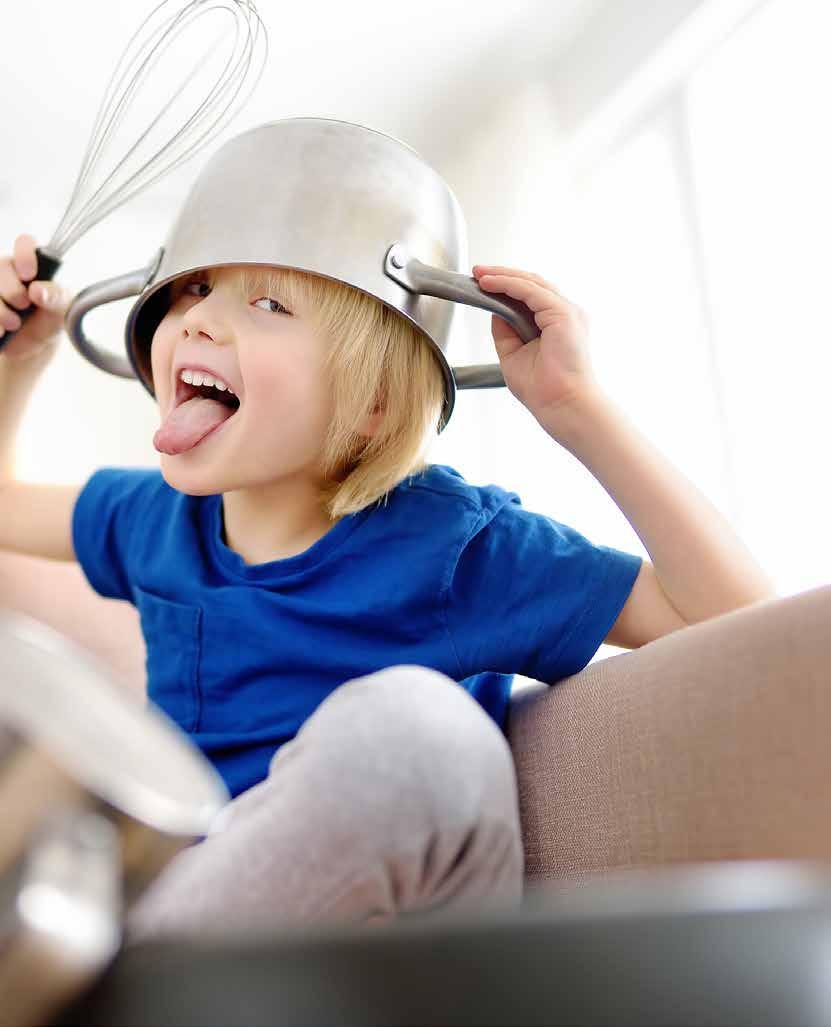

Self-control issues
Impulsivity can look like quick reactions or decisions made without thinking, often showing up as interrupting conversations. If your child frequently talks over others, cuts in during conversations or struggles with turn-taking, it could be impulsivity at work. Additionally, difficulty waiting their turn is a key indicator. Whether in line, during games, or in the classroom, kids with ADHD may express frustration or impatience when expected to wait. Impulsivity can also look like acting without thinking. Impulsive behaviours might include running into the street suddenly, grabbing toys, or reacting strongly to emotions.
While many children are naturally energetic, children with ADHD may have particular challenges managing that energy. They may always seem to be in motion, even when sitting. Fidgeting and restlessness may be particularly noticeable. Another sign is excessive talking or noise-making - in this case they might hum, make noises or talk continuously, regardless of the situation or activity. Lastly, difficulty with quiet activities can be an indicator, as engaging
in calm or quiet play can be challenging for hyperactive children. They may avoid activities like reading or crafts, instead preferring play based around action.
ADHD symptoms may look different depending on where your child is and what they’re doing. Here’s how they might appear in various settings:
Structured environments like school are often where ADHD symptoms stand out. You may notice your child has difficulty paying attention in class, struggles with instructions or has trouble sitting still during lessons. Homework time can also be challenging, with distractibility and fidgeting making it hard to complete their assignments.
ADHD might impact your child’s ability to interact socially. They may appear impatient, interrupt their friends or struggle to take turns
in games. These behaviours can affect their friendships if they aren’t managed, leading to frustration for both your child and their peers.
At home, ADHD behaviours can become apparent during daily routines like meals or bedtime. You may see that it’s tough for your little one to sit through dinner, follow their bedtime steps, or wait patiently for their turn during family games. These situations can sometimes lead to tensions, especially when routines are interrupted.
Every child has periods of high energy, shorter attention spans or impulsive reactions. So how can you tell the difference between these typical stages and ADHD? The main way is to ask yourself whether these behaviours are persistent and occur in lots of different settings. Are they on a level that impacts daily life? If these behaviours frequently interfere with your child’s success at school, their ease in family life or their friendships, there might be a need for further evaluation. Age is also a factor. Younger
children, especially those under age six, naturally develop these skills over time. ADHD usually becomes more noticeable as children get older and still struggle with the same issues.

ADHD often shows up differently in girls than in boys, which can sometimes delay or complicate a diagnosis. While boys tend to display more externalised behaviours, like hyperactivity and impulsivity, girls with ADHD may exhibit more subtle signs. These can include being easily distracted, daydreaming or seeming inattentive. Girls often channel their energy differently, using coping strategies to hide symptoms and trying very hard to ‘fit in’, which can make their struggles tougher to spot. They might be perceived as ‘shy’ or ‘scattered’ rather than recognised for experiencing symptoms of ADHD.
Girls with ADHD may also face unique emotional challenges. Many girls feel social pressure to be agreeable, which can lead them to mask or internalise ADHD-related stress, often resulting in frustration or low self-esteem. Social dynamics can compound this - girls with ADHD may struggle with friendships and experience anxiety over fitting in, as they can sometimes misread social cues or interrupt conversations. Again, teachers and parents might overlook these patterns, associating them with teenagehood rather than ADHD.
Because the symptoms in girls can be quieter, they’re often missed in school assessments and evaluations - girls are rarely diagnosed at a young age. Recognising these subtle signs is so important, as addressing ADHD symptoms early on is much better, helping your daughter grow in confidence, self-esteem and life skills from a younger age.
If you’re noticing persistent ADHD symptoms or you have any concerns, it’s best to talk to
your doctor or a child psychologist, who can advise you on how to move forward. Whether you pursue a formal diagnosis or not, there are various ways you can support your little one at home to help them flourish if they’re showing attention or behavioural difficulties.
Children with ADHD benefit greatly from structure. Having simple, clear routines creates a sense of order, helping children feel secure and know what to expect. Visual charts or checklists can be especially helpful for younger kids, providing a fun and accessible way to follow their daily routines.
Clear, achievable goals can make all the difference for a child with ADHD. Using a reward system like star charts can offer them encouragement and give them a tangible way to track and celebrate their achievements.
Frequent breaks can work wonders for focus! Incorporating physical activity into your child’s day will help them manage any excess energy and improve their concentration. It doesn’t need to be a big deal - a quick outdoor play
session or some stretching can be just what they need to refocus!
Children with attention challenges benefit from feeling understood and valued. Listening to their experiences and saying a few words of encouragement can stave off any overwhelm they may be prone to. Remember, small words of praise, for effort rather than outcome, builds resilience and self-esteem - all vital for a child with ADHD!
Children with ADHD often bring incredible creativity, enthusiasm and zest for life. By focusing on their strengths, you can help them develop confidence and use these gifts to their advantage. So try to cultivate a positive and nurturing home environment that lets kids explore their potential in ways that work best for them.
For parents, understanding ADHD is a key first step, empowering you with knowledge and resources that make a difference in your child’s life. Supporting a child with ADHD is a journey, but with patience, understanding and a little flexibility, you can guide them in building the skills they need to succeed, embrace themselves as they are and navigate the world with confidence.

How to improve children’s maths skills naturally and ways to help kids flourish at languages.
How can you build up your child’s maths confidence and abilities through small daily interactions?
Maths doesn’t have to be reserved for classrooms or homework tables - in fact, some of the best maths practice can happen right at home through everyday routines! By integrating numbers and patterns into daily activities, children can grow comfortable with maths in a relaxed, natural way.
The kitchen is a fantastic place to learn maths. Cooking and baking offer perfect opportunities to explore concepts like measurement, fractions and

ratios. It’s good to let your children help measure ingredients for a recipe, using cups, tablespoons and teaspoons to introduce the basics of measurement. You might ask, “If this recipe calls for one cup of sugar, how many half-cups do we need?” This exercise lets children see fractions in action and reinforces addition and division as they measure and mix.
Household chores can be a surprisingly effective way to strengthen counting and sorting skills. Encourage your child to count items as they complete tasks - counting the number of plates to set at the dinner table, folding socks in pairs or counting toys as they tidy up. When putting laundry away, sorting clothes by colour or type is another neat way to encourage pattern recognition. Making these activities part of daily chores helps children understand that numbers are everywhere, not just on worksheets.
Shopping trips and allowances are a great way to introduce basic budgeting and money management. Kids can help with simple budgeting at the supermarket - just give them a list of items and an estimated budget, and encourage them to keep a running
total. For younger kids, identifying prices and counting coins for smaller items can make the concept of money more fun. Practising addition, subtraction and even a little multiplication through shopping gives real-world context to maths skills, building familiarity with numbers and budgeting.
Patterns are the building blocks of maths and they can be found all around us. Ask your child to look for patterns in nature or at home, like the tiles on the floor, or create them through play - think building blocks, beads or drawing designs. If your child enjoys art, creating colourful patterns is a fun way to develop early geometry skills. Observing and creating patterns supports logic, sequencing and a foundational understanding of mathematics.
Learning to tell time reinforces maths skills, from understanding numbers and sequences to managing addition and subtraction. Simply start by teaching your little one to read both digital and analogue clocks. Talk about the concepts of “half past” and “quarter to” for fractions and explain how sixty seconds make a minute, giving them practical knowledge of counting by fives. Using these terms regularly helps solidify time concepts in their everyday routine.
Bringing maths into daily life can make the subject a lot more approachable and fun for children. By working maths into these routines, you’ll help your child see it as part of the world around them and build essential skills along the way!

We focus on the simple ways you can support your child in learning a second language fluently.
In today’s interconnected world, being multilingual isn’t just a skill - it’s a superpower! Encouraging your child to learn new languages offers benefits far beyond fluency. It helps their cognitive development, boosts their academic grades, and even helps them connect with diverse cultures. What’s more, with a bit of planning and support, you can turn language learning into a fun and enriching journey for your child.
Children’s brains are like sponges, making the early years the perfect time to introduce new languages. Research shows that starting language learning before puberty can lead to better pronunciation, grammar comprehension and overall fluency. Moreover, exposing young kids to multiple languages helps improve problem-solving skills, memory and even multitasking abilities!
When kids grow up speaking more than one language, they also gain a broader perspective on the world. Understanding different cultures and being able to communicate with people from varied backgrounds makes children more open-minded and empathetic.
Learning a language doesn’t have to be a chore. In fact, the more interactive and enjoyable you can make it, the more likely your child will stay engaged and motivated. Instead of relying solely on traditional textbooks and the classroom, try weaving language learning into everyday activities.
For instance, you can incorporate songs, games and storytelling in the target language. Singing along to catchy tunes in Spanish, French or Arabic can make vocabulary stick, while languagebased games, like memory matching or word bingo, turn practice into play. Even watching animated films or TV shows in another language (with subtitles) can introduce your child to native pronunciation and expressions while keeping things fun.
One of the best ways to help your child succeed with languages is by creating opportunities for everyday exposure. Consistency is key!
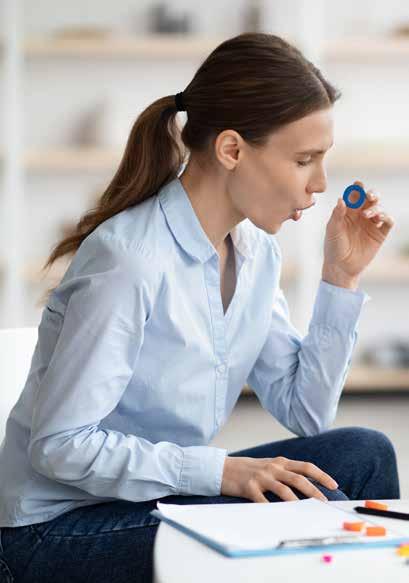
You can dedicate certain times of day to speaking only in the new language, or introduce bilingual toys and books into your child’s playtime routine.
Labelling household items in the language your little one is trying to learn is another simple yet effective method. For example, placing labels on the fridge saying “le réfrigérateur” (French) or “el refrigerador” (Spanish) helps reinforce the vocabulary without much effort. These small adjustments gradually and easily build familiarity and comfort.
If you or another family member speaks a second language fluently, consider using it at home. Immersing your child in the language, even for brief periods, can greatly boost their understanding and fluency. Language camps, playgroups and language-specific extracurricular activities are also fantastic ways to make language learning a part of your child’s social experience.

Schools can play a pivotal role in language acquisition, but it’s important to support what your child is learning in the classroom. Connect with your child’s teachers to understand what topics are being covered and how you can reinforce this learning at home.
For example, if your child is learning about animals in French, you can find related books, TV shows or even take a trip to the zoo while using only French vocabulary. Asking open-ended questions like, “What’s the French word for ‘tiger’ again?” keeps
your child’s language skills sharp and makes them feel like experts in the subject!
It’s also worth exploring local language clubs, language learning apps like Duolingo, or interactive resources like Rosetta Stone for extra practice. These tools often provide gamified learning experiences that captivate children and make learning feel like play.
It’s normal for children to feel shy or unsure when speaking a new language. Creating a supportive and low-pressure environment is key to building their confidence. Avoid focusing on mistakes; instead, offer gentle corrections and encouragement. Try rephrasing their sentences correctly without directly pointing out errors. For example, if your child says, “I goed to the park,” you can respond with, “Oh, you went to the park? That sounds fun!” This way, they learn the correct form without feeling discouraged.
Patience is crucial. Language learning takes time, and each child progresses at their own pace. Setting small, achievable goals, like learning five new words a week, can help maintain momentum without overwhelming your child.
Language learning isn’t just about memorising words and grammar; it’s about embracing new ways of thinking and understanding different perspectives. Encourage your child to explore the cultures associated with the language they’re learning. This could involve cooking a traditional dish from the country, celebrating cultural holidays or attending local events where the language is spoken.
Understanding cultural contexts not only deepens your child’s appreciation for the language but also makes the learning experience richer and more meaningful. It turns language learning into a holistic adventure, connecting your child to a broader global community.
It’s natural to want quick results, but language learning is a marathon, not a

sprint. Set realistic expectations for your child’s progress and avoid comparing them to others. Remember, even small steps are a sign of growth.
Encourage your child to enjoy the journey of learning, rather than striving for perfection. It’s okay if they mix up words or struggle with pronunciation - this is all part of the process! By showing patience and enthusiasm, you’re teaching them resilience and perseverance.
Every achievement, big or small, deserves celebration. Did your child say a full sentence in the target language? Make it a special moment! Whether it’s a high-five, a sticker, or a little treat, these celebrations reinforce positive feelings towards language learning.
You can also consider rewarding progress with experiences related to the language. A family trip to a restaurant that serves cuisine from the country or watching a movie in the language are enjoyable ways to mark milestones and inspire further learning.
Helping your child succeed with languages is a wonderful gift that can open doors throughout their life. With consistent exposure, patience and a playful approach, your child will not only become more fluent but also gain a lifelong love for languages and the many opportunities they bring.
Four fabulous family staycations; an exotic mini break to Mauritius and more!

What goes into managing a relaxing holiday with children? We take a look!

Travelling with children in tow can be an uncertain undertaking! The worry of potential tantrums, restlessness and meltdowns is tough, but with a bit of extra preparation and flexibility, it can be an exciting adventure for everyone. The right approach can help manage any stressors and help things run as smoothly as possible.
Choosing the right destination is key to a successful trip. Look for places that offer kid-friendly activities, safe environments and ample opportunities for family time. Also, have a think about what your little ones love - is it sandy beaches, theme parks or even cultural experiences? If you feel comfortable, involve your little ones in the planning process and ask them what they’d like to see or do, as this gives them a sense of ownership over the trip too - which leads to more cooperation!

When it comes to packing for your little ones, less is often more. Make a checklist of the essentials, focusing on items that can serve multiple purposes. For example, a lightweight stroller can also double as a place for your child to rest during long days of exploring. Of course, don’t forget their comfort items too, as their favourite toys or blankets can provide a sense of security in unfamiliar environments. Lastly, it’s good to pack snacks and activities to keep your kids entertained during travel, whether you’re on a plane, train or in the car.
While it’s great to have an itinerary, being too rigid can lead to plenty of frustrations. Children thrive on routine, but they also benefit from the freedom to explore and play - so, it’s wise to allow for downtime in your schedule for your kids to recharge. This might mean scheduling a leisurely afternoon at the hotel pool or allowing spontaneous visits to nearby parks. Flexibility will help you manage any unexpected changes, helping you move on from any hitches more easily.
Long journeys can be daunting, let’s be honest. It can be helpful to fill travel time with fun activities, like colouring or travel bingo. Audiobooks and podcasts tailored to kids can make the time fly by as well, sparking
their imagination and keeping them engaged. Overall it’s about finding whatever you can to make the ‘travel’ part more exciting.
Travelling with children can sometimes bring about challenges - be it tiredness or boredom. It’s important to stay calm and patient in these moments, however hard that might feel. Practising deep breathing together can help manage stress and if your child is overwhelmed, feel free to step away for a moment to regroup. Remind yourself that these incidents happen and you can’t control everything. Hassle-free family travel is a practice and you’re doing a great job!
Travelling with kids may require more preparation and patience, but it can lead to unforgettable family adventures. With thoughtful planning and enough flexibility, you can have the experience you’re hoping for and inspire your little ones to explore the world with a positive attitude.


With the UAE National Day long weekend approaching, Sunlife Resorts Mauritius is offering a fantastic discount to get away for a short, but sweet four day break.
An easy journey from the region, Mauritius is an ideal holiday destination for the whole family - and with daily flights from Dubai and Abu Dhabi, reaching this tropical paradise is pretty effortless!
Sunlife Resorts Mauritius is giving a twenty percent discount for 3-night, 4-day stays at the luxurious Long Beach Resort and the Sugar Beach Resort - perfect for next month’s long weekend. The special offer applies to all room types and meal plans, with extra savings on upgrades to full board or all-inclusive options.
Long Beach Mauritius, a five star resort, provides the perfect mix of luxury,
relaxation and a plethora of activities for families. Whether you’re looking for a peaceful retreat or an action-packed holiday, Long Beach Mauritius has something for everyone. Notably, the resort is also home to one of Africa’s top five restaurants, Hasu, a contemporary Japanese eatery.
For those seeking tranquillity, you can unwind with the signature Mauritian Journey treatment at the newly launched GLOW wellness centre, all while soaking in the pristine views of the Indian Ocean. Golf enthusiasts can also enjoy complimentary and unlimited green fees at two world-class
courses - the iconic Ile Aux Cerfs Golf Club and the Anahita Golf Club. Play a round solo, with friends, or family - and even introduce little ones to the game with the Junior Golf program.
From pampering sessions at the children’s spa to a fantastic sports and recreation program at the teen club, filled with exciting excursions and outings, there’s plenty to keep kids entertained and happy.
Located on the famous Flic-en-Flac Beach, Sugar Beach Mauritius offers a grand and glamorous sanctuary with indulgent sunset views over a white sandy beach. The resort is home to the renowned Buddha-Bar Beach, the perfect spot for a delicious lunch or dinner right by the water’s edge, serving world-class seafood and sushi.
Sugar Beach is a family-friendly haven where up to two children under 12 can stay and dine for free. With access to the kids and teen clubs, young guests can enjoy different activities, ranging from paddleboarding to arts and crafts, plus their own buffet and swimming pool - how lovely!
Your family can indulge in a high tea experience at the Sugar Beach Tea Room where you’ll discover the rich history of Mauritian tea rituals, enhanced with tropical sweets, for a delightful late afternoon treat. You can also enjoy family golf at two stunning courses - the Tamarina Golf Club, an 18-hole championship course, and the Ile Aux Cerfs Golf Club. Alternatively, try the Cosmic Journey at GLOW, featuring ancient remedies and sensory experiences that transport you into a state of deep relaxation and heightened awareness.
If your family is looking for a rejuvenating escape this UAE National Day, a holiday to Mauritius could be just what you need!
Visit www.longbeachmauritius.com and www.sugarbeachmauritius.com to book your stay.
With the weather cooling down, it’s a great time to escape to some of the UAE’s most luxurious destinations.

Whether your family is seeking beachfront serenity, elevated city living or cultural charm, these four curated staycations offer an ideal break without leaving the country.
Nestled in the heart of Sharjah, The Chedi Al Bait seamlessly blends the emirate’s rich cultural history with modern-day luxury. Set within meticulously restored heritage houses, the resort is a tranquil retreat that celebrates the charm of Arabian architecture. Here, you can explore the neighbouring arts district or take a leisurely walk through the winding souks that surround the property.
The Private House experience presents two refined residences, each featuring private pools and jacuzzis. House 1 has five spacious bedrooms, while House 2 is a duplex design, with four bedrooms and a movement studio. Both houses include daily breakfast and are ideal for family holidays, promising unmatched privacy and personalised service.
For more information, visit: https://www.ghmhotels.com/en/the-chedial-bait-sharjah.
Rising high above the bustling streets of Dubai, One&Only One Za’abeel is a striking blend of urban sophistication and luxury. With panoramic views of the city skyline, this
architectural marvel is ideal for refined city living. Families can explore the resort’s cuttingedge wellness experiences at the Longevity Hub or unwind at the scenic rooftop pool.
For a more indulgent staycation, the UAE Ultimate Staycation package gives exclusive savings on room rates and daily gourmet breakfast at Aelia, along with 20% off all

dining outlets. With top-tier service, this is an effortless retreat in the heart of Dubai.
For reservations, visit https://www. oneandonlyresorts.com/one-zaabeel.
Tucked away on the western crescent of the iconic Palm Jumeirah, One&Only The Palm offers a serene private beachfront retreat. Surrounded by lush gardens and soft golden sands, the resort is a lovely setting for families to unwind. At its heart is the renowned Guerlain Spa, which promises to deeply restore your body and mind.

The resort’s Beachfront Villa Escape involves private pools and spacious living areas. Here, you can indulge in leisurely afternoons at The Lounge and rejuvenating spa treatments daily. With fantastic service and a great blend of relaxation and adventure, One&Only The Palm is a truly idyllic getaway.
Visit https://www.oneandonlyresorts.com/ the-palm for more.
Set along Dubai’s pristine coastline, One&Only Royal Mirage boasts stunning architecture, inspired by the splendour of Arabian palaces, providing a perfect backdrop for a family trip. From water sports to dining experiences that celebrate the best of local and international cuisines, your family will have plenty to enjoy.

For a more private stay, the Villa Escape package offers you a Beach Garden Villa with direct beach access and a personal pool. The package includes a personalised host service, daily spa treatments or an in-villa hammam, and meals prepared by a private chef. With a private fitness studio and a dedicated beachside gazebo, the villa is perfect for those seeking both wellness and tranquillity by the sea.
For further information, visit https://www.oneandonlyresorts.com/ royal-mirage.
Making the most of the smallest spaces and the benefits of cleaning your home without chemicals.

Compact nooks don’t have to feel cramped! Discover simple, stylish ways to maximise your home’s smallest rooms and make every corner functional and fun.
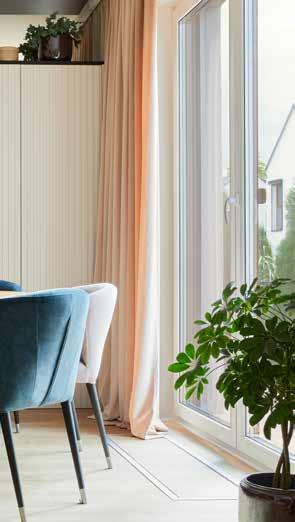
When it comes to making the most of small spaces, it can be hard to know where to start. Whether it's a snug living room, a cute bedroom or a tiny balcony, you can transform these areas into functional, stylish parts of your home with just a few simple strategies. Here are some ideas to help you maximise your smaller spaces, making every square inch count, while creating an environment that feels cosy and welcoming for your family.
In a small space, furniture that serves multiple purposes can be a game-changer. Why not consider a sofa bed for guests or an ottoman with built-in storage? Pieces like fold-out tables or desks can be tucked
away when not in use, freeing up valuable space around your home. Choosing items that adapt to your needs can make your room feel more open and adaptable, and therefore less confined.
When floor space is limited, think vertically! Shelves, hooks and hanging storage allow you to maximise your wall space, creating extra storage without crowding the room. Consider floating shelves for books or plants, wallmounted desks or even hanging baskets for kitchens and bathrooms. It’s a simple way to keep your family’s essentials accessible and add visual interest to your space at the same time - a win-win!
Light colours, such as whites, creams and soft pastels, help make a room appear larger and more open. If your walls, furniture and decor are on the lighter side, the whole area feels brighter and less enclosed. Mirrors, too, are a secret weapon in small spaces - they reflect light and create the illusion of added depth. So, try placing a large mirror opposite a window or near a light source for maximum effect and experiment until you find what works best in your smaller space. This is a
handy trick that can also be utilised outdoors using mirrors that are suitable for outside.
Keeping your small space uncluttered and well-organised is key here. A minimalist approach, with just a few select decor pieces and essentials, can prevent the area from feeling cramped. Where possible, opt for furniture with hidden storage to keep your belongings out of sight, and give each item a purpose. When every piece in your space has meaning and functionality, the room becomes both calming and practical, and much more user-friendly for your household.
It can be good to create the sense of different ‘zones’ within the same space. For example, you could use a rug to mark a reading nook in your living room or a small shelf to distinguish a work area. Even in a compact area, defining spaces can make your home feel larger and more organised.
With these simple tips, even the smallest spaces can feel open, stylish and uniquely yours. All it takes is a little planning and creativity, and you’ll make a big impact in any little nook of your home in no time!
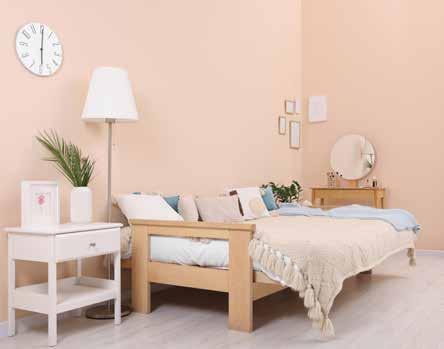
We look at everything you need to know to get started with natural cleaning methods, along with some easy DIY recipes and practical tips.

When it comes to keeping a clean, healthy home, many of us automatically reach for the brightly coloured bottles of commercial cleaning products. But did you know that the synthetic chemicals they contain can contribute to poor indoor air quality, irritated skin and even pose risks to your family’s health? As parents, creating a safe environment for our little ones is always a top priority. Thankfully, there’s a growing movement towards natural, chemical-free cleaning solutions that are just as effective, but kinder to both our health and the environment! So, consider switching things up and making your home shine without relying on harsh chemicals.
Cleaning products are often loaded with ingredients like ammonia, chlorine and phthalates - substances that can be harmful when inhaled, ingested or when they come into contact with skin. Prolonged exposure to these chemicals can trigger allergies, asthma
and other respiratory issues, especially in young children whose immune systems are still developing.
Switching to natural, chemical-free cleaning methods can significantly reduce these risks, eliminating our exposure to unnecessary toxins and creating a healthier indoor environment. Not to mention, many chemical-free alternatives are more environmentally friendly, and by making your own, you can also save money.
One of the best parts about going chemical-free is that you can use simple, everyday ingredients you probably already have in your kitchen to double up as powerful cleaning agents!
With its mild acidity, white vinegar can cut through grease, dissolve limescale and disinfect surfaces. It’s a fantastic all-rounder for
cleaning kitchens and bathrooms, though be careful not to use it on natural stone surfaces, which can be damaged by acidic substances.
Mildly abrasive, baking soda is a wonderful scrub for sinks, countertops and grout. It also has natural deodorising properties, making it great for freshening up carpets, bins and fridges.
Lemons are naturally antibacterial and have a fresh, uplifting scent. Their acidity makes them ideal for tackling hard water stains and brightening white surfaces.
Made from vegetable oils, castile soap is a gentle, non-toxic cleaner that can be used on its own or combined with other ingredients for a variety of cleaning tasks.
Tea tree, eucalyptus, lavender and citrus essential oils not only give off a lovely fragrance, they also have natural antibacterial and antifungal properties. Add a few drops to your cleaning solutions for a gorgeous scent and an extra germ-fighting boost.
You don’t have to be a chemistry whiz to do this - these simple recipes can tackle a wide range of your household’s cleaning needs and are super safe!
Simply combine equal parts water and white vinegar in a spray bottle and add a few drops
of your favourite essential oil. This mixture is perfect for cleaning glass, countertops and everyday spills. However, avoid using vinegar on marble, granite or other stone surfaces.
This one is easy! Just mix a cup of baking soda with a few tablespoons of water to form a paste. Use this to scrub stubborn stains in sinks, bathtubs or on tiles. Add a squirt of your favourite castile soap for an extra boost.
Take half a cup of white vinegar and add the juice of one lemon and one cup of water. Spray onto your kitchen surfaces or chopping boards to disinfect them and leave everything smelling citrus-fresh!
Carpets are notorious for being a little bit stale, but also carpet cleaners have a reputation for being particularly harsh and unsuitable around kids. Instead, try sprinkling baking soda mixed with a few drops of essential oil over your carpets or rugs. Let it sit for fifteen minutes before vacuuming up. It sounds too good to be true, but this promises to neutralise any odours and freshen up your space.
What should you keep in mind when choosing this method of greener, safer cleaning?
Chemical-free cleaning might require a little more elbow grease and time, especially if you’re dealing with stubborn stains. Trust that the results are worth it and take your time scrubbing and allowing the natural ingredients to work their magic.
While natural ingredients are generally safe, some combinations can reduce effectiveness or create unwanted reactions. For instance, never mix vinegar and baking soda for a longterm cleaning solution, as they neutralise each other. They can be used on the same task (for instance to unclog a drain) but should be sprayed or used separately.

Even when using natural cleaning products, it’s a good idea to keep your home wellventilated. Open your windows or turn on fans to help air out your rooms and ensure fresh airflow, especially if you use vinegar or strong-smelling essential oils.
Microfiber cloths are perfect for chemicalfree cleaning as they attract dirt, dust and grime with just water. They’re great for surfaces, glass and floors, and can be washed and reused multiple times - ideal!
One of the wonderful things about chemicalfree cleaning is that it’s safe enough for children to participate in. So get kids involved in simple tasks like dusting with a microfiber cloth or wiping down surfaces with a gentle all-purpose cleaner. This not only lightens your load but is also a safe way to teach little ones some essential life skills! You can even make it fun by playing music or turning it into a challenge!

By making the switch to natural cleaning products, you’re not only creating a safer environment for your family but also doing your part to reduce the chemical load on our planet. With a little experimentation and a shift in mindset, you’ll find that chemicalfree cleaning is just as effective, if not more satisfying, than using store-bought alternatives. So, next time you reach for a cleaner, consider giving your DIY solutions a go!
How to achieve glowing skin this winter and the Editor’s favourite hair and beauty recommendations for November!


Cooler days in the UAE might be a sigh of relief after all that heat, but I find that my skin can struggle with the switch to drier air. Here are my top tips for keeping that soft, luminous glow all winter long. Let’s get into it!
Even in the cooler months, the dry UAE air can leave your skin parched. My advice is to layer on a hydrating serum as a base layer to lock in moisture - look for hyaluronic acid or glycerin, both superb for plumpness and moisture. Then, follow with a rich moisturiser to seal it all in, creating a barrier that wards off environmental factors that contribute to dryness. And remember, just because the sun feels cooler doesn’t mean it’s gone - an SPF is still essential to prevent UV damage.
Dull skin is such a challenge at this time of year! To avoid it, try a gentle exfoliant once or twice a week. Skip the rough scrubs and look for a mild chemical exfoliant with lactic or glycolic acid - these do wonders without stripping your skin, helping to keep it smooth and prepped for absorbing moisture from the rest of your products.
Facial oils are the ultimate barrier against the season’s harsh effects. Light oils like squalane or jojoba are perfect - they add a protective, nourishing layer without feeling thick or clogging, which is ideal for winter in the UAE, where our skin needs protection from the dry air without the weight of richer formulas. I like to apply them as the last step of my night-time routine for that soft, plump feeling in the morning.
Indoor heating can dry out the air and your skin along with it! Adding a humidifier to your space helps keep the air moist, making it easier for your skin to stay hydrated. It’s a gamechanger for preventing that dry, tight feeling that can come with the onset of winter.

The right products are essential, but staying hydrated from within is half the battle. Keep sipping on water and don’t shy away from vitamin C-rich fruits like oranges and berries. These not only support skin from the inside, but will add a little brightness to your complexion too - a win-win!
When it’s chilly, even mild cleansers can feel a bit much, and over drying the skin is all too easy! I’d encourage you to switch to a creamy or oil-based cleanser, to remove impurities without stripping your natural oils. Steer clear of anything too foamythis season is all about keeping things soft and supple.
With just a few easy tweaks like these, you’ll be able to enjoy fresh, radiant skin all winter long!

'Tis the season to treat your skin to the care it deserves! Athena Dermatology Clinic, located in Onyx Tower, The Greens, has some amazing festive offers, valid until December 31st and designed to have you glowing from head to toe! Let’s take a look…
Imagine the power of ice, hydration and gentle exfoliation all in one! CryoGlow is the ultimate skin pick-me-up, using a unique ice-needling technique to boost serum absorption, leaving your skin plump, dewy and refreshed. Priced at 1200 AED (down from AED 1500), the onehour treatment includes exfoliation, a vitamin C mask, serum, and a hydrating mask.
Wave goodbye to dull, tired skin with the clinic’s rejuvenating skin boosters for just AED 1200 per syringe. You can choose from Profhilo, Restylane Vital, or Sunekos 200 to flood your skin with deep hydration,

improving your elasticity and stimulating your collagen production, for that lit-from-within glow!
Take your skin to the next level with the dynamic duo of Morpheus8 and Profhilo, priced down to AED 3500. This treatment combines microneedling and radiofrequency to boost your collagen deep within, tackling fine lines, sagging skin and acne scars. The added Profhilo supercharges your results, giving you a youthful, firm complexion for the holidays.
I know dry air can play havoc with my skin’s moisture levels! This combo treatment is so good for tackling this, and is now available for just AED 1200. The Athena Hydrating Facial drenches your skin in moisture, while Aquagold uses micro-channeling tech to push custom serums into your skin, for a long-lasting glow.
Get your skin's texture in check with Skinpen microneedling. This treatment creates tiny channels in the skin, triggering your own collagen production and tackling issues like pigmentation, acne scars and uneven texture. Priced at AED 1400 until December 31st, it's a game-changer for smooth, radiant skin. Visit www.athenaderma.com or contact +971506458869 for more information.
Indulge in the luxury of Kama Ayurveda's products, featuring authentic Ayurvedic formulations without harmful chemicals. These all-natural, balanced solutions prioritise long-term efficacy and wellness over temporary results, a philosophy I really admire. From nourishing hair oils to rejuvenating skin treatment oils, Kama Ayurveda offers a holistic approach to beauty that packs a punch.
I particularly like their Rose and Jasmine hair cleanser. With the hair colouring, heat styling and chemical treatments that the holiday season often brings, this natural and mild hair cleanser restores your hair’s lustrous beauty from the inside out. Free of SLES,

its powerful Ayurvedic ingredients put life back into dry and damaged locks by leaving the hair's natural oils intact. Soy protein binds moisture, organic aloe vera and hibiscus offer deep hydration, while rose and jasmine essential oils nourish and revitalise your strands for a healthy-looking bounce. What’s not to love?
Kama Ayurveda products are available at https:// misspalettable.com.



